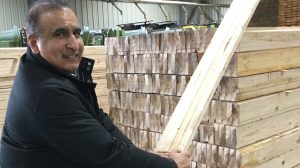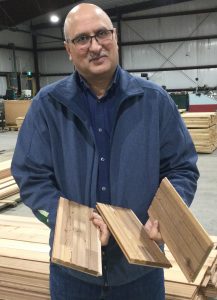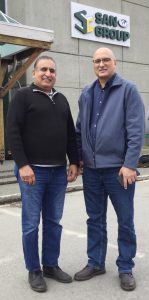Langley-based Firm Investing Heavily In Secondary Wood Manufacturing in Port Alberni

San Group CEO Kamal Sanghera with one of their value-added wood products
PORT ALBERNI – For decades, government and labour have bemoaned the absence of significant secondary wood manufacturing companies in British Columbia.
As they watched raw logs shipped to other countries, where those raw materials were turned into “gold”, i.e. value-added wood products, many of which, ironically, have been shipped back to Canada for sale
The San Group is starting to turn the tables on this highly-debated dialogue, as their value-added wood products using an assortment of BC fiber are being sold as finished products throughout the world – as well as in their home province.
“We have the recipe,” states Chief Executive Officer Kamal Sanghera. “We have the practical working study right here. . .not in a forecast, in real time. It’s working, it’s real money, and it’s creating jobs and eliminating greenhouse gases and preserving the life of our natural resources.”
President Suki Sanghera, Kamal’s brother, adds “It is important to note that we term value-added wood products as a finished wood product, manufactured to its highest degree ready for purchase by the homeowner.

San Group President Suki Sanghera shows the back of one of their new siding products
“These are products such as tables, siding, flooring, railing, doors, shelving. We have innovated and constructed a network of integrated manufacturing units to create these products so that our wood product never travels over a distance of 7 kilometres from log manufactured to finished product.”
The San Group is arguably on the “cutting edge” of the BC forestry industry, which has seen 60 per cent of its sawmills close in the last 30 years. Their fiber supply includes salvaged wood and burnt forest fire wood from all over, including Smithers and Terrace, from which they produce over 20 different value-added wood products for export from hemlock, cypress, cedar and Douglas fir, from trees as small as three inches in diameter.
For example, one product features ¾ inch x ¾ inch wood, laminated together with cedar veneer on one side, which becomes attractive tongue-and-groove wood siding. They also recently reached an agreement to provide products for Lowes.
Imagine what the company could do if it had its own Tree Forest License (TFL)?
They have made several overtures to purchase Vancouver Island’s TFL 44, and continue to express an interest in obtaining cutting rights on Crown land, along with the promise to turn more of that wood into value-added products, as opposed to shipping them overseas as raw logs.
Kamal argues that opening up tree forest licenses to companies like the San Group would provide two and a half times the amount of revenue to provincial coffers than is currently generated by stumpage rates. They believe their operational model could create over 4,500 new manufacturing jobs across the province in the next decade.
The brothers travel the globe to visit customers and sign contracts for their products, and their ventures have exposed them to ideas, processes and machinery from all over the world, some of which they’ve brought home. A half million dollar painting machine has just arrived from Italy. They have a unit that slices – not cuts – veneer from lumber, leaving no sawdust or residuals.
They also come home with pre-sold orders, and their plants make exactly what the customer wants.

CEO Kamal Sanghera, left, and his brother, President Suki Sanghera, lead the San Group
“That’s the way H.R. MacMillan and his team at forestry pioneer MacMillan Bloedel used to do it, says Kamal. “They had the recipe right here in BC, and people forgot about it.”
The San Group started in the lumber industry on the lower mainland in 1979 and today offers timber harvesting, sawmilling, lumber remanufacturing and value-added lumber manufacturing. Their products are distributed in over 27 countries.
They purchased Coulson Forest Products in 2017, and have since completed a new sawmill in Port Alberni – the first on Vancouver Island in two decades – as well as a new 300,000 square foot value-added manufacturing facility in town. They have invested over $150 million so far.
At the start of 2020, the San Group had 290 employees. Two years later, there are over 625 workers in the company operations, which includes five manufacturing plants, including Port Alberni, and their head office in Fort Langley. From 2020 to 2021, sales have increased over 75 percent.
The San Group has created 350 new jobs in Port Alberni, which is most welcome.
“Our children and grandchildren are heading to the lower mainland to get work,” says Suki. “We’re providing good paying jobs here so that they can stay and be close to their families.”
They’re also supporting the local community in various ways, including buying tickets for children to accompany their parents to watch the Alberni Bulldogs play in the BC Hockey League.
In addition, former Port Alberni Mayor Mike Ruttan is on the San Group team, overseeing the company’s latest project, Pacific Mayfair: 1,200 new homes on land east of West Coast General Hospital near Wolf Creek. They are planning to build a plant to create wood pellets from sawdust, while other residual wood waste is utilized in co-generation units to produce power for the plants. They have other plans and opportunities under consideration, but their style is to do a project, then announce it once it’s done.
Kamal says there are three things that don’t exist in the brothers’ vocabulary: Can’t do it, Impossible and Tomorrow.
“No one believed us when we announced our projects. We were laughed at,” recalls Kamal. “They said, ‘Why Vancouver Island? It can never work. Who invests in a new mill on the Island, let alone into value added manufacturing?’
“We said ‘No, this can work on the Island. Why not create jobs and utilize the fiber to its fullest?’ And that is exactly what we did. Yet, we created one of the largest, efficient and most carbon friendly plants in the world. We don’t need to manufacture our fiber overseas, it comes from Vancouver Island, so let’s create the jobs here. So we did it.”


